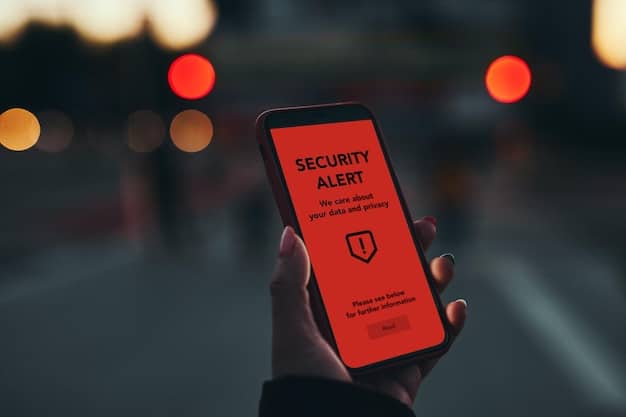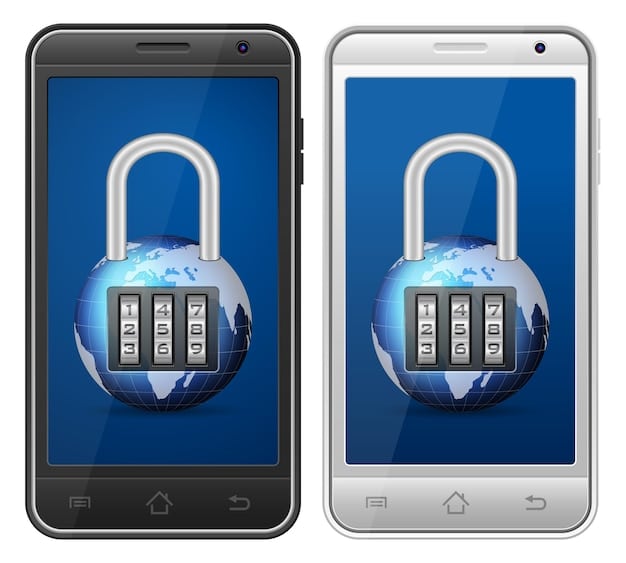Mobile Device Security: 7 Steps for US Companies to Protect Data

Mobile device security is crucial for US companies to protect sensitive data on employee phones; implementing measures such as strong passwords, encryption, and regular software updates can significantly reduce the risk of data breaches and cyber threats.
In today’s business landscape, **mobile device security: 7 steps to protect your company’s data on employee phones in US** is no longer optional—it’s a necessity. With employees increasingly using their smartphones and tablets for work, these devices become potential gateways for cyber threats. Securing this vulnerable endpoint is vital for protecting sensitive company information.
Understanding the Mobile Security Landscape in the US
The mobile security landscape in the US is constantly evolving, presenting both challenges and opportunities for businesses. As mobile devices become more integrated into daily operations, the risk of data breaches and cyberattacks via these endpoints increases, making a robust mobile security strategy crucial for any US-based company.
Companies must stay ahead of emerging threats and understand the specific vulnerabilities associated with mobile devices. Regular assessments and updates to security policies are essential to maintain a strong defense against potential attacks.

The Rising Threat of Mobile Malware
Mobile malware is a significant concern for businesses, as it can compromise sensitive data and disrupt operations. Understanding the types of malware and how they infiltrate devices is crucial for implementing effective security measures.
- Trojan Horses: Disguised as legitimate apps, these can steal data or grant unauthorized access.
- Ransomware: Encrypts device data, demanding payment for its release, disrupting business operations significantly.
- Spyware: Secretly monitors user activity, collecting personal and company information without consent.
To counter these threats, companies should utilize mobile threat detection (MTD) solutions and educate employees on identifying and avoiding suspicious apps and links.
In conclusion, understanding the mobile security landscape involves recognizing both the opportunities and the challenges presented by mobile devices. By staying informed and proactively addressing potential vulnerabilities, businesses can ensure the security of their data and operations.
Step 1: Develop a Comprehensive Mobile Security Policy
Developing a comprehensive mobile security policy is the foundational step in protecting company data on employee phones. This policy should outline clear guidelines and expectations for mobile device usage, ensuring that employees understand their roles and responsibilities in maintaining security.
By creating a well-defined policy, businesses can establish a framework for consistent security practices across all mobile devices used for work.
Key Elements of Your Mobile Security Policy
A robust mobile security policy should cover various aspects of device usage, from password requirements to data encryption. Here are some essential elements to include:
- Password Management: Enforce strong, unique passwords and regular password changes.
- Device Encryption: Mandate encryption to protect data at rest and in transit.
- Acceptable Use: Define permissible activities and prohibited behaviors on company-related devices, avoiding access of sites that host illegal content or that promote hate speech.
Implementing these elements will help mitigate risks and ensure that mobile devices are used safely and responsibly.
In conclusion, a comprehensive mobile security policy is essential for setting clear expectations and guidelines for mobile device usage. By addressing critical areas such as access controls, data protection, and incident response, companies can establish a strong foundation for mobile security.
Step 2: Implement Strong Password and Authentication Protocols
Implementing strong password and authentication protocols is a critical step in securing mobile devices and protecting company data. Weak passwords and inadequate authentication methods can leave devices vulnerable to unauthorized access and data breaches.
By enforcing robust password policies and utilizing multi-factor authentication, businesses can significantly enhance their mobile security posture.

Best Practices for Password and Authentication
To ensure strong password and authentication protocols, consider implementing the following best practices:
- Multi-Factor Authentication (MFA): Require users to provide multiple forms of verification, such as a password and a code sent to their phone.
- Biometric Authentication: Utilize fingerprint or facial recognition for secure and convenient access.
- Password Complexity: Enforce strong passwords with a mix of upper and lower case letters, numbers, and symbols.
These measures add layers of security, making it more difficult for attackers to gain unauthorized access to mobile devices and company data.
In conclusion, strong password and authentication protocols are vital for securing mobile devices and protecting company data. By implementing these practices, businesses can significantly reduce the risk of unauthorized access and data breaches.
Step 3: Secure Mobile Devices with Encryption
Securing mobile devices with encryption is a fundamental step in protecting sensitive company data. Encryption converts data into an unreadable format, making it incomprehensible to unauthorized users even if the device is lost or stolen.
By implementing encryption, businesses can ensure that their data remains confidential and secure, regardless of the physical security of the device.
Types of Encryption for Mobile Devices
There are several types of encryption that can be implemented on mobile devices, including:
- Full-Disk Encryption: Encrypts the entire device, including the operating system and all data.
- File-Level Encryption: Encrypts individual files or folders, providing more granular control over data protection.
- Containerization: Creates a secure container on the device for storing and accessing sensitive data.
Choosing the right type of encryption depends on the specific needs and security requirements of the business.
In conclusion, encryption is a powerful tool for securing mobile devices and protecting company data. By implementing encryption, businesses can ensure that their data remains confidential and secure, even in the event of device loss or theft.
Step 4: Implement Mobile Device Management (MDM) Solutions
Implementing Mobile Device Management (MDM) solutions is essential for maintaining control and security over mobile devices used for business purposes. MDM solutions provide a centralized platform for managing devices, enforcing security policies, and monitoring device usage.
By using MDM, businesses can ensure that all mobile devices meet security standards and can be remotely managed and secured.
Benefits of Using MDM Solutions
MDM solutions offer a range of benefits, including:
- Remote Device Management: Remotely configure settings, install apps, and wipe data from lost or stolen devices.
- Policy Enforcement: Enforce security policies such as password requirements, encryption, and software updates.
- Monitoring and Reporting: Monitor device usage and generate reports to identify potential security risks.
These capabilities enable businesses to maintain a high level of security and control over their mobile device fleet.
In conclusion, MDM solutions are critical for managing and securing mobile devices used for business. By providing centralized control and security features, MDM solutions help businesses protect their data and maintain a strong security posture.
Step 5: Keep Software and Apps Updated Regularly
Keeping software and apps updated regularly is an essential practice for maintaining mobile device security. Software updates often include critical security patches that address known vulnerabilities, protecting devices from potential exploits.
By ensuring that all software and apps are up to date, businesses can significantly reduce the risk of security breaches and data compromise.
The Importance of Timely Updates
Timely updates are crucial because they address:
- Security Vulnerabilities: Patches that fix known security flaws, preventing exploitation by attackers.
- Bug Fixes: Resolves issues that could lead to system instability or data corruption.
- Performance Improvements: Enhances device performance and user experience.
Ignoring updates can leave devices vulnerable to security threats and performance issues.
In conclusion, regular software and app updates are essential for maintaining mobile device security. By staying current with updates, businesses can protect their devices from known vulnerabilities and ensure optimal performance.
Step 6: Train Employees on Mobile Security Best Practices
Training employees on mobile security best practices is a critical step in creating a security-aware culture and protecting company data. Employees are often the first line of defense against cyber threats, so it’s essential to educate them on how to recognize and avoid potential risks.
By providing regular training, businesses can empower employees to make informed decisions and protect their mobile devices and company data.
Key Topics for Mobile Security Training
Mobile security training should cover the following topics:
- Phishing Awareness: Teach employees how to identify and avoid phishing scams.
- Safe Browsing: Educate on safe browsing habits and avoiding suspicious websites.
- Data Protection: Emphasize the importance of protecting sensitive data and following company security policies.
These training sessions should be interactive and engaging, reinforcing key concepts and best practices.
In conclusion, training employees on mobile security best practices is essential for creating a security-aware culture. By equipping employees with the knowledge and skills to protect their devices and data, businesses can significantly reduce the risk of security breaches.
Step 7: Monitor and Respond to Security Incidents
Monitoring and responding to security incidents is an essential step in maintaining mobile device security. Continuous monitoring can help detect potential threats and vulnerabilities, allowing businesses to respond quickly and effectively to security incidents.
By establishing a robust incident response plan, businesses can minimize the impact of security breaches and protect their data.
Elements of an Effective Incident Response Plan
An effective incident response plan should include:
- Detection: Implement tools and processes for detecting security incidents.
- Containment: Take immediate action to contain the incident and prevent further damage.
- Recovery: Restore affected systems and data to normal operation.
Regular testing and updates to the incident response plan are essential to ensure its effectiveness.
In conclusion, monitoring and responding to security incidents is crucial for maintaining mobile device security. By establishing a robust incident response plan, businesses can minimize the impact of security breaches and protect their data.
| Key Point | Brief Description |
|---|---|
| 🛡️ Security Policy | Develop clear guidelines for mobile device use. |
| 🔒 Strong Passwords | Enforce complex passwords and MFA. |
| 🔄 Regular Updates | Keep software and apps up to date. |
| 🚨 Incident Response | Monitor and respond to security incidents quickly. |
FAQ: Mobile Device Security
Mobile device security is important for businesses as employee devices store and access sensitive data. A security breach can cause a data breach and disrupt operations.
Key elements include strong password requirements, device encryption, acceptable use policies, and procedures for lost or stolen devices. These ensure your company’s information stays safe.
Encryption transforms data into an unreadable format, protecting it from unauthorized access even if the device is lost or stolen. Thus ensuring data privacy.
Updates include security patches that fix vulnerabilities, protecting devices from cyber threats. Always install updates to stay safe when using the internet on your phone.
Training should cover phishing awareness, safe browsing habits, data protection, and how to report security incidents. This ensures employees are the first responders when facing a threat.
Conclusion
Implementing these seven steps will significantly enhance your company’s mobile device security posture. By prioritizing these measures, US companies can protect their sensitive data, maintain operational integrity, and foster a security-conscious culture among their employees, ensuring a safer and more secure business environment.





